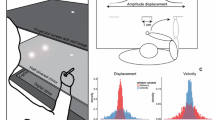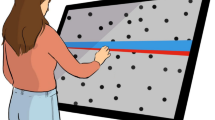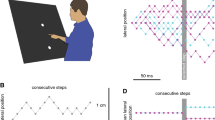Abstract
Previous work has indicated that people do not use their judgment of a target's speed to determine where to hit it. Instead, they use their judgment of the target's changing position and an expected speed (based on the speed of previous targets). In the present study we investigate whether people also ignore the target's apparent direction of motion, and use the target's changing position and an expected direction of motion instead. Subjects hit targets that moved in slightly different directions across a screen. Sometimes the targets disappeared after 150 ms, long before the subjects could reach the screen. This prevented subjects from using the target's changing position to adjust their movements, making it possible to evaluate whether subjects were relying on the perceived or an expected (average) direction to guide their movements. The background moved perpendicular to the average direction of motion in some trials. This influences the target's perceived direction of motion while leaving its perceived position unaffected. When the background was stationary, subjects hit disappearing targets along their trajectory, just as they hit ones that remained visible. Moving the background affected the direction in which subjects started to move their hand, in accordance with the illusory change in direction of target motion. If the target disappeared, this resulted in a hit that was systematically off the target's trajectory. If the target remained visible, subjects corrected their initial error. Presumably they did so on the basis of information about the target's changing position, because if the target disappeared they did not correct the error. We conclude that people do use the target's perceived direction of motion to determine where to hit it. Thus the perceived direction of motion is treated differently than the perceived speed. This suggests that the motion of an object is not broken down into speed components in different directions, but that speed and direction are perceived and used separately.








Similar content being viewed by others
References
Ball K, Sekuler R (1987) Direction specific improvements in motion discrimination. Vision Res 27:953–965
Brenner E, Smeets JBJ (1997) Fast responses of the human hand to changes in target position. J Mot Behav 29:297–310
Brenner E, Smeets JBJ, Lussanet MHE de (1998) Hitting moving targets: continuous control of the acceleration of the hand on the basis of the target's velocity. Exp Brain Res 122:467–474
Brenner E, Smeets JBJ, Berg AV van den (2001) Smooth eye movements and spatial localisation. Vision Res 41:2253–2259
Brouwer A, Brenner E, Smeets JBJ (2000) Hitting moving objects: the dependency of hand velocity on the speed of the target. Exp Brain Res 133:242–248
Brouwer A, Brenner E, Smeets JBJ (2002) Hitting moving objects: Is target speed used in guiding the hand? Exp Brain Res 143:198–211
Derrington A, Suero M (1991) Motion of complex patterns is computed from the perceived motions of their components. Vision Res 31:139–149
Festa EK, Welch L (1997) Recruitment mechanisms in speed and fine-direction discrimination tasks. Vision Res 37:3129–3143
Francis G, Kim H (2001) Perceived motion in orientational afterimages: direction and speed. Vision Res 41:161–172
Geisler WS (1999) Motion streaks provide a spatial code for motion direction. Nature 400:65–69
Georgopoulos AP, Kalaska JF, Massey JT (1981) Spatial trajectories and reaction times of aiming movements: effects of practice, uncertainty, and change in target location. J Neurophysiol 46:725–753
Glover S (2002) Visual illusions affect planning but not control. Trends Cogn Sci 6:288–292
Glover S, Dixon P (2001) Motor adaptation to an optical illusion. Exp Brain Res 137:254–258
Glover S, Dixon P (2002) Dynamic effects of the Ebbinghaus illusion in grasping: support for a planning/control model of action. Percept Psychophys 64:266–278
Hubbard TL (1995) Environmental invariants in the representation of motion: implied dynamics and representational momentum, gravity, friction, and centripetal force. Psychon Bull Rev 2:322–338
Kerzel D (2002) The locus of "memory displacement" is at least partially perceptual: effects of velocity, expectation, friction, memory averaging and weight. Percept Psychophys 64:680–692
Kowler E, van der Steen J, Tamminga EP, Collewijn H (1984) Voluntary selection of the target for smooth eye movement in the presence of superimposed, full-field stationary and moving stimuli. Vision Res 24:1789–1798
Loffler G, Orbach HS (2001) Anisotropy in judging the absolute direction of motion. Vision Res 41:3677–3692
Matthews N, Qian N (1999) Axis-of-motion affects direction discrimination, not speed discrimination. Vision Res 39:2205–2211
Matthews N, Welch L (1997) Velocity-dependent improvements in single-dot direction discrimination. Percept Psychophys 59:60–72
Matthews N, Luber B, Qian N, Lisanby SH (2001) Transcranial magnetic stimulation differentially affects speed and direction judgments. Exp Brain Res 140:397–406
Mita T, Hironaka K, Koike I (1950) The influence of retinal adaptation and location on the "Empfindungszeit." Tohoku J Exp Med 52:397–405
Mitrani L, Dimitrov G, Yakimoff N, Mateeff S (1979) Oculomotor and perceptual localization during smooth eye movements. Vision Res 19:609–612
Nakayama K (1985) Biological image motion processing: a review. Vision Res 25:625–660
Prablanc C, Martin O (1992) Automatic control during hand reaching at undetected two-dimensional target displacements. J Neurophysiol 67:455–469
Schweigart G, Mergner T, Barnes GR (2003) Object motion perception is shaped by the motor control mechanism of ocular pursuit. Exp Brain Res 148:350–365
Smeets JBJ, Brenner E (1995a) Perception and action based on the same visual information: distinction between position and velocity. J Exp Psychol Hum Percept Perform 21:19–31
Smeets JBJ, Brenner E (1995b) Prediction of a moving target's position in fast goal-directed action. Biol Cybern 73:519–528
Smeets JBJ, Brenner E, de Lussanet MHE (1998) Visuomotor delays when hitting running spiders. In: Bril B, Ledebt A, Ditrich G, Roby-Brami A (eds) EWEP 5—advances in perception-action coupling. EDK, Paris, pp 36–40
Smeets JBJ, Brenner E, de Grave DDJ, Cuijpers RH (2002) Illusions in action: consequences of inconsistent processing of spatial attributes. Exp Brain Res 147:135–144
Smeets JBJ, Glover S, Brenner E (2003) Modeling the time-dependent effect of the Ebbinghaus illusion on grasping. Spat Vision 16:311–324
Soechting JF, Lacquaniti F (1983) Modification of trajectory of a pointing movement in response to a change in target location. J Neurophysiol 49:548–564
Stone LS, Watson AB, Mulligan JB (1990) Effect of contrast on the perceived direction of a moving plaid. Vision Res 30:1049–1067
Westheimer G, Wehrhahn C (1994) Discrimination of direction of motion in human vision. J Neurophysiol 71:33–37
Westwood DA, McEachern T, Roy EA (2001) Delayed grasping of a Muller–Lyer figure. Exp Brain Res 141:166–173
Acknowledgements
The first author was supported by the Netherlands Organization for Scientific Research (NWO Grant 575-23 015) and by the European Commission (Grant HPRN-CT-2002-00226).
Author information
Authors and Affiliations
Corresponding author
Rights and permissions
About this article
Cite this article
Brouwer, AM., Middelburg, T., Smeets, J.B.J. et al. Hitting moving targets. Exp Brain Res 152, 368–375 (2003). https://doi.org/10.1007/s00221-003-1556-8
Received:
Accepted:
Published:
Issue Date:
DOI: https://doi.org/10.1007/s00221-003-1556-8




